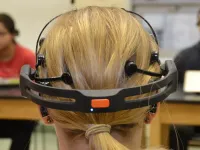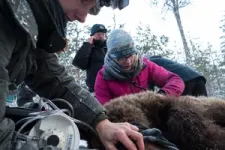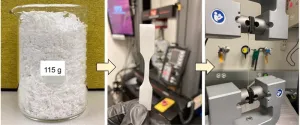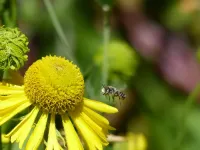(Press-News.org) Students whose brainwaves are more in sync with their classmates and teacher are likely to learn better than those lacking this “brain-to-brain synchrony,” shows a new study by a team of psychology and education researchers. The findings, which appear in the journal Psychological Science, offer new insights into the learning process.
“This is the first study to show that the extent to which students’ and teachers’ brainwaves are in sync during real-world learning can predict how well students retain information from class,” says lead author Ido Davidesco, an assistant professor at the University of Connecticut’s Neag School of Education and a former postdoctoral fellow at New York University, where the study was conducted.
“Much of human learning happens when we interact with others, but very little is known about how this process is reflected in the brain activity of students and teachers,” adds Suzanne Dikker, a research professor at NYU’s Department of Psychology and one of the paper’s senior authors. “This work reveals that students whose brainwaves are more in sync with their peers and teacher are likely to learn better.”
Our understanding of how the brain supports learning in a social setting is limited because learning is typically studied in individual participants in controlled laboratory settings. In the Psychological Science paper, the team sought to study brain function in a real-world, group context.
To do so, the researchers used electroencephalography (EEG), a commonly used method where a cap with electrodes is placed on the head. This method allowed the researchers to track the electrical brain activity of small groups of undergraduate students and an instructor—none of the participants knew each other prior to the study.
In these sessions, the instructors gave short lectures on a variety of scientific topics; during the lecture period, both the students’ and the instructors’ brainwaves were monitored.
Afterwards, students took multiple-choice tests to gauge what they had learned.
The researchers found that as students were listening to the lecture, their brainwaves became in sync with one another. Moreover, the researchers observed such “brain-to-brain synchrony”—similar brain-activity patterns over time—between the students’ brainwaves and when comparing students’ brainwaves to the teacher’s brainwaves. Critically, students whose brain activity was more in sync with their peers and with the teacher learned better—as shown in higher post-lecture test scores. In fact, the researchers were able to effectively predict which test questions students would answer correctly based on how in sync their brainwaves were during the moments of the lecture that corresponded to each question.
The authors emphasize that it’s the connection among students and to their instructor that is telling about the learning process. In fact, the researchers could not derive how well students retained information from looking at individual students’ brainwaves—only synchrony in brainwaves between students and teachers predicted how well students learned.
“Brain data collected simultaneously from groups of students can be more informative than data collected from individual students,” Davidesco observes.
The paper’s other authors were Emma Laurent, a doctoral student at Harvard University, Henry Valk, a data scientist at Pison Technology, Inc., Tessa West, a professor in NYU’s Department of Psychology, Catherine Milne, a professor in NYU’s Steinhardt School of Culture, Education, and Human Development, and David Poeppel, a professor in NYU’s Department of Psychology and managing director of the Ernst Strüngmann Institute for Neuroscience in Frankfurt, Germany.
The research was supported by a grant from the National Science Foundation (ECR-1661016).
An image of the EEG device may be downloaded from Google Drive.
# # #
END
In sync brainwaves predict learning, study shows
Students learn better when their brainwaves are in sync with their classmates and teacher
2023-04-13
ELSE PRESS RELEASES FROM THIS DATE:
Researchers discover tiny galaxy with big star power using James Webb telescope
2023-04-13
Using first-of-their-kind observations from the James Webb Space Telescope, a University of Minnesota Twin Cities-led team looked more than 13 billion years into the past to discover a unique, minuscule galaxy that generated new stars at an extremely high rate for its size. The galaxy is one of the smallest ever discovered at this distance—around 500 million years after the Big Bang—and could help astronomers learn more about galaxies that were present shortly after the Universe came into existence.
The paper is published in Science, one of the world's top peer-reviewed academic journals.
The University of Minnesota researchers were one of the first teams to study ...
Humans, and piglets, and bears, oh my! Preventing dangerous blood clots
2023-04-13
“Don’t poke the bear”, they said. But that’s exactly what a team of scientists have been doing, to discover the secrets of blood clotting.
Hibernating bears, paralysed humans, and pigs kept in small enclosures all avoid dangerous blood clots, despite being immobile for extremely long periods.
Research from the University of Reading, with partners in Denmark, Germany, Norway and Sweden, shows that reduction of a key protein prevents the formation of blood clots in all three mammal species when they ...
UTSA astrophysicist leads international team in discovery of new exoplanet outside Earth’s solar system
2023-04-13
(SAN ANTONIO) April 13, 2023 - An international research team led by UTSA Associate Professor of Astrophysics Thayne Currie has made a breakthrough in accelerating the search for new planets.
In a paper slated for publication April 14 in Science, Currie reports the first exoplanet jointly discovered through direct imaging and precision astrometry, a new indirect method that identifies a planet by measuring the position of the star it orbits. Data from the Subaru Telescope in Hawai`i and space telescopes from the European Space Agency (ESA) were integral to the team’s discovery.
An ...
Shift to ‘flash droughts’ as climate warms
2023-04-13
Embargoed: Not for Release Until 19:00 (7.00 pm) British Summer Time, Thursday, 13 April 2023
Shift to ‘flash droughts’ as climate warms
‘Flash droughts’ have become more frequent due to human-caused climate change and this trend is predicted to accelerate in a warmer future, according to research published today [13 April 2023] involving the University of Southampton.
The research published in Science shows that flash droughts, which start and develop rapidly, are becoming ‘the new normal’ for droughts, making forecasting and preparing for their impact more difficult.
Flash ...
First Nations populations at greater risk of severe flu, research finds
2023-04-13
First Nations populations at greater risk of severe flu, research finds
Responsible for over 5 million infections and 100,000 deaths every year, influenza remains one of the most challenging public health issues for populations globally, particularly First Nations communities.
New research from the Peter Doherty Institute for Infection and Immunity (Doherty Institute) has found that First Nations populations around the world are significantly more likely to be hospitalised and die from influenza compared to non-Indigenous populations.
Researchers from the Doherty ...
Channeling mechanical energy in a preferred direction
2023-04-13
A research group led by scientists from the RIKEN Center for Emergent Matter Science have developed a unique material, based on nanofillers embedded in a hydrogel, that can channel mechanical energy in one direction but not the other, acting in a “nonreciprocal” way. With this composite material--which can be constructed at various sizes--the team was able to use vibrational up-and-down movements to make liquid droplets rise within a material against gravity. Using this material could thus make it possible to make use of random vibrations and move matter in a preferred direction.
Channeling energy in a preferred direction is an ...
Chemists redesign biological PHAs, ‘dream’ biodegradable plastics
2023-04-13
They’ve been called “dream” plastics: polyhydroxyalkanoates, or PHAs. Already the basis of a fledgling industry, they’re a class of polymers naturally created by living microorganisms, or synthetically produced from biorenewable feedstocks. They’re biodegradable in the ambient environment, including oceans and soil.
But there’s a reason PHAs haven’t taken off as a sustainable, environmentally benign alternative to traditional plastics. Crystalline PHAs are brittle, so not as durable and convenient as conventional plastics. They cannot easily be melt-processed and recycled, making them expensive to produce.
Colorado State ...
Bees flock to clearcut areas but numbers decline as forest canopy regrows, OSU research shows
2023-04-13
CORVALLIS, Ore. – Native bees in the Oregon Coast Range are diverse and abundant in clearcut areas within a few years of timber harvest but their numbers drop sharply as planted trees grow and the forest canopy closes, research by Oregon State University shows.
The findings are important for understanding the roles forest management might play in the conservation of a crucial pollinator group, the researchers said.
The study, led by graduate student Rachel Zitomer and Jim Rivers, an animal ecologist in the OSU College of Forestry, was published in Ecological Applications.
“The research demonstrates ...
Global study finds some women experience heavier menstrual flow after COVID-19 vaccination
2023-04-13
A new international study finds that women vaccinated for COVID-19 have a slightly higher risk for a heavier period after vaccination.
The study, led by Oregon Health & Science University reproductive health services researcher Blair Darney, Ph.D., M.P.H., and physician-scientist Alison Edelman, M.D., M.P.H., published today in the British Journal of Obstetrics and Gynaecology. These findings build on prior work from the same research team that first identified an association between COVID-19 vaccines ...
Virtual fitting rooms can be a double-edged sword
2023-04-13
AMES, IA – Driven by online shopping, a growing number of retailers have launched virtual fitting rooms in recent years. That includes Amazon, the top apparel seller in the U.S., along with Nike, Macy’s and Walmart. The virtual rooms allow shoppers to ‘try on’ clothes through interactive simulation technology and texture-mapped product images. It can cut down on returns and nudge hesitant shoppers to click the checkout button.
But findings from a recently published study indicate virtual fitting rooms could backfire on retailers if they assume ...
LAST 30 PRESS RELEASES:
Sleeping in on weekends may help boost teens’ mental health
Study: Teens use cellphones for an hour a day at school
After more than two years of war, Palestinian children are hungry, denied education and “like the living dead”
The untold story of life with Prader-Willi syndrome - according to the siblings who live it
How the parasite that ‘gave up sex’ found more hosts – and why its victory won’t last
When is it time to jump? The boiling frog problem of AI use in physics education
Twitter data reveals partisan divide in understanding why pollen season's getting worse
AI is quick but risky for updating old software
Revolutionizing biosecurity: new multi-omics framework to transform invasive species management
From ancient herb to modern medicine: new review unveils the multi-targeted healing potential of Borago officinalis
Building a global scientific community: Biological Diversity Journal announces dual recruitment of Editorial Board and Youth Editorial Board members
Microbes that break down antibiotics help protect ecosystems under drug pollution
Smart biochar that remembers pollutants offers a new way to clean water and recycle biomass
Rice genes matter more than domestication in shaping plant microbiomes
Ticking time bomb: Some farmers report as many as 70 tick encounters over a 6-month period
Turning garden and crop waste into plastics
Scientists discover ‘platypus galaxies’ in the early universe
Seeing thyroid cancer in a new light: when AI meets label-free imaging in the operating room
Neutrophil-to-lymphocyte ratio may aid risk stratification in depressive disorder
2026 Seismological Society of America Annual Meeting
AI-powered ECG analysis offers promising path for early detection of chronic obstructive pulmonary disease, says Mount Sinai researchers
GIMM uncovers flaws in lab-grown heart cells and paves the way for improved treatments
Cracking the evolutionary code of sleep
Medications could help the aging brain cope with surgery, memory impairment
Back pain linked to worse sleep years later in men over 65, according to study
CDC urges ‘shared decision-making’ on some childhood vaccines; many unclear about what that means
New research finds that an ‘equal treatment’ approach to economic opportunity advertising can backfire
Researchers create shape-shifting, self-navigating microparticles
Science army mobilizes to map US soil microbiome
Researchers develop new tools to turn grain crops into biosensors
[Press-News.org] In sync brainwaves predict learning, study showsStudents learn better when their brainwaves are in sync with their classmates and teacher








